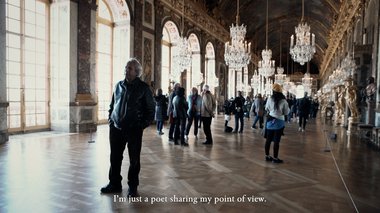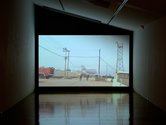John Hurrell – 18 June, 2024
Iraq: Spheres of Influence has a brilliant accompanying catalogue—edited by Ewen McDonald—containing (alongside stills from Norrie's film) excellent discussions about the Treaty of Versailles (1919) and the Sykes-Picot Agreement (1916). The former was between T. E. Lawrence and the Arab leader Emir Feisal focussing on Palestine; and the latter between France and Britain, endorsing a contrary arrangement made between Britain and the Israelis.
This film by Susan Norrie was commissioned by the Canberra-based Australian War Memorial. It focuses on Iraq, the tensions in the Middle East, and informally dwells on the presence of Australian and New Zealand troops put there (with Iraqi soldiers) ostensibly as a buffer against ISIS. Her trip was brief and so she ended up with a kind of diary that looks at their daily routines and more importantly includes an extended interview with exiled Iraqi poet Salah Al Hamdani in Versailles about the history of the conflict in the Middle East.
Iraq: Spheres of Influence has a brilliant accompanying catalogue—edited by Ewen McDonald—containing (alongside stills from Norrie’s film) excellent discussions about the Treaty of Versailles (1919) and the Sykes-Picot Agreement (1916). The post WW1 conference had T. E. Lawrence and the Arab leader Emir Feisal asking for Palestine (as a reward for Arab help in defeating the Turks, but being rejected by France and Britain, who endorsed a secret contrary arrangement made between Britain and the Israelis.
Harold Pinter’s scathing 2005 Art, Truth & Politics Nobel essay about Bush’s and Blair’s deceitful involvement is probably still the clearest commentary on the Iraq situation—and similar in many ways to the view of Salah Al Hamdani. (It is published in Pinter’s anthology of plays and poetry.) Al Hamdani believes the West makes a lot of money selling arms to participants in the Middle East conflicts and that those profits are enjoyed by Europe.
Norrie’s film presents Salah Al Hamdani explaining his point of view, and the publication has terrific back-up explanations by Juliana Messina and Aaron W. Hughes of the damaging consequences of the previously mentioned clashing treaties.
Susan Norrie of course has an exemplary history as an innovative artist skilled at making sensual and conceptually intriguing paintings—before she began pursuing film-making. The 2016 diptych she presents here is uncharacteristically a photorealist work, but it depicts a young male soldier having his face blow-dried, allowing his complexion to be improved with a face pack. It is almost a monochrome.
This painting could be a comment about a ‘new’ masculinity, or sensitivity, or vanity: a grunt preparing for a night out locally or a trip back home. It can also be a vague question about male sexuality and its conventional assumptions. Or the whiteness of the cosmetic face pack is a droll comment needling European colonialism. The slipperiness of the image stretches one’s interpretative facilities and is unsettlingly ambiguous in the way that the best art often is.
John Hurrell








 Two Rooms presents a program of residencies and projects
Two Rooms presents a program of residencies and projects Advertising in this column
Advertising in this column



This Discussion has 0 comments.
Comment
Participate
Register to Participate.
Sign in
Sign in to an existing account.